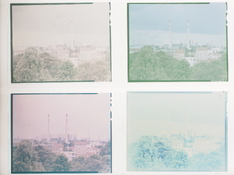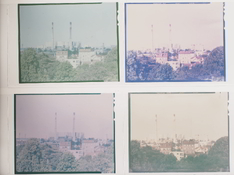New tests, with one stop more exposed films, from ISO 20 to ISO 50 :
Fujichrome Astia RAP Exp 08/2003
Kodak Ektachrome EPN exp 09/2003 (I think opened since a too long time, those 50 sheets boxes must be quickly shot after opening)
Fujichrome Provia RDP III exp 08/2004
dev : XT-3 stock + 6 drops of Benzotriazole + a pinch of sodium thiosulfate at 38 ° C for 7 mn 30 sec
Everything else same as previously mentioned : stop, wash, light fogging with an 5300 K 180 w LED, C41 dev, bleach, wash, fix, wash and stab, all at 38 ° C
Too clear, looks overexposed
then the same shots developed with the same developper and additives for 9 mn 30 sec, I wanted to be sure that more development was more clear (that was not clear in my mind ;^)
Still overexposed, and more contrasted, I'm just pushing the films.
I couldn’t manage to edit the one by one shots (it’s very similar and somehow very different) so here are the same picture with the two developing times, four by four, no colour editing, Olympus EM5 + 60 Macro (it's inside Panodia P45 protecting sleeves so, maybe not the best scans I've made) :
On the right side, the two last are sandwiches of very overexposed EPN, two on top, maybe four down, it gives some kind of 3 D.
Another attempt with a less active developer (400 ml dev + 300 ml water) and the same additives, the colour cast is different (except for the EPN) and 2 more stops closed, it’s less overexposed… better.
And 2 different 120 films, an Kodak 160 T EPT exp 07/2002 and an unknown date Fujichrome Provia 100 (RDP II is old) had been tried, developed in the same tank as the 4 x 5’’ more successful one :
Unfiltered tungsten film in daylight is always...
Pinkish haze, pinkish HAAAZE !
A fast and dirty light and contrast edit of the cat that's living around the house (the slide is as tiny as the one above, but with a magnifier on the light-table, it's beautiful ):
8 seconds at f:8, Apo-Symmar 240:5,6 with a lot of tilt front and back, the kitten's lying on a bed that's dark blue !
Ok, the developper is still too strong or too long. I’ll try next with an 1 + 1 dilution and some drops of Rodinal or HC-110 part A sirup, and less time.
And of course I have to try the RA-4 colour dev thing.
And I could try, to have an idea, some E6 FD found in a closet, without the rest of the kit (salvaged for the blix ;o), maybe some drops of pure one in the XT-3 !
Anyway, colour cross processing gives a cast to the film that’s very variable depending on the film base itself and of course, the age is an important factor. I’ve done that hundreds if not thousands times with E-6 films developed in C-41, Velvia, Astia and Fujichrome MS 100/1000 has the emerald green mask (the MS 100/1000 is more cyan), Ektachrome 100 SW is very magenta, Tungsten films all tend do have a yellow mask (guess why ;o) and some Agfa and Konica films give a very deep blue mask (nearly impossible to see thru), more modern emulsions are much more flat, like Fujichrome Sensia and Provia (same film and Agfa Precisa CT that’s also the exactly the same) with a slight purple base and Kodak Ectachrome 100 G, and the new 100 E also with a completely clear transparent base.
So the quest for a perfect colour rendition is not my goal, I just want to be able to use those films in positive with a good result enough, and I kinda like the results so far, I’m getting a nice new palette of colours, still a little dull (I'm a Velvia fanboy so, not used to pastel colours).
And it’s more convenient (and fast, and cheaper) to have the positive directly, as I’m used to shoot again my negatives with the same process to have a positive !







